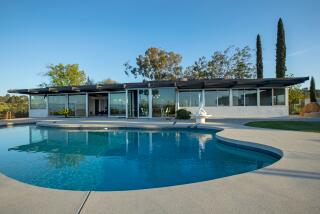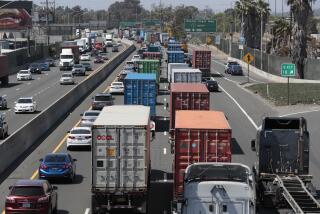Low-Polluting Auto Paint Debuts : Environment: The water-based primers are now in use in 4,000 body repair shops in the Los Angeles area.
- Share via
When the South Coast Air Quality Management District mandated a switch from oil-based to water-based paints two years ago, auto-paint manufacturers and body-shop owners warned that the public had better prepare for lower-quality, more expensive repainting jobs--if they could meet the requirements at all.
Today, three months after the new rule went into effect, virtually all major auto paint companies have fielded the first of the new water-based, low-polluting products. And 4,000 auto paint shops in the Los Angeles area are learning to adapt to the change.
“They cried earlier that they could not meet the standard,” says Moustafa Elsherif, program supervisor in the rule development division of AQMD. “Now they are meeting it.”
However, to some extent, the manufacturers’ fears have been borne out. For one thing, the new water-based paints are more expensive to use--at least initially. For another, many auto body shops are suspicious of the quality of the new water-based primers, the first stage of complete new paint systems that will eventually include primers, cleaners, clear coatings, solvents and the different color coatings used to paint cars.
“It was a surprise to find that major national paint companies could come out with new products, especially when they were so negative on the chance of coming out in the time frame allowed,” said a cautious Jim Compton, vice president of the San Fernando Valley chapter of the California Autobody Assn., which represents almost 700 body shops and associate members in California. “But lo and behold,” he said, “when that time frame came to pass, we had products on the shelf.”
DuPont Co., PPG Industries Inc., BASF Corp., Sherwin-Williams Co., and Sikkens Car Refinishes, a division of Akzo Coatings Inc., are among those that have marketed water-based primers to meet the new AQMD standards.
Body-shop owners point out that consumers are increasingly picky about their auto paint jobs, and that the new paints will be difficult to judge without years of experience.
“They are demanding more and more and more quality,” says Robert Turnage, owner of Autocraft of Torrance, Inc., who has been in the auto body and paint business for 11 years.
“How are we ever going to please these people?”
Yet for some auto repair shop owners, their current complaints are directed more at the insurance companies than the AQMD rules.
Some auto-repainters say that insurers have yet to adjust their rates to the increased costs of using the new paints. The paints are more difficult to use, require changes in equipment and the products themselves cost from 10% to 40% more than the old.
“To a certain extent we’ve been totally unregulated,” Turnage says of the auto-repainting industry. “The industry just isn’t prepared for it, and we’re not getting any help from the insurance companies.”
Insurers say that under existing rate-setting procedures, the shop owners will have adequate opportunity to make their case.
“If governmental agencies are making them incur more costs it would show up in an increased labor rate, which we survey every year around February or March,” said Jay Guertin, a claims manager in the Costa Mesa regional office of State Farm Mutual Automobile Insurance Co.
State Farm also added a requirement this year that auto body shops guarantee their paint jobs for one year, a change that Guertin denied was tied to uncertainties over the new water-based paints.
The older auto paints contained what are called volatile organic compounds or VOCs, which are major components of photochemical smog. According to the AQMD, auto-spray paint shops, which had been unregulated until the district’s rule 1151 was set in 1988, were emitting far more VOCs than South Coast Air Basin oil refineries--38.5 tons daily, compared to 15.6 tons from the refineries. An estimated 1,200 tons of these VOCs have been released daily in recent years.
“And they were wasting a lot of paint, because the spray equipment wasn’t very efficient,” said Bill Kelly, a spokesperson for the AQMD. “The paint they were using was also extremely volatile, so much of it was evaporating into the air.”
All this will be a major topic of debate for repair shop owners Friday, Saturday and Sunday at the annual California Autobody Assn. trade show and convention, in Anaheim.






